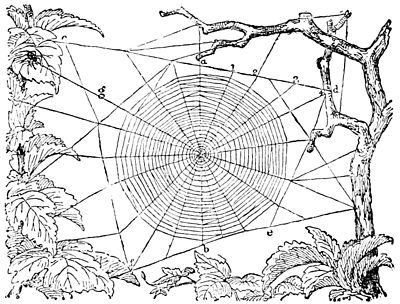it displays the resources of its intelligence; it makes the repairs that are called for in a way that will command the attention of the intelligent observer. Particular tools are necessary for executing works demanding precision. Accordingly, the claws of the epeïra are of a much more complicated construction than those of other spiders. One of them is cleft so as to form a fork, with which the artist is able to hold its threads and put them precisely where they are wanted to be.

Fig. 8.—Web of the Garden Spider.
In attack, the epeïra holds itself in the center of the web, head down. If an insect strikes against the network, it precipitates itself upon the game, which instantly finds itself held and tied in such a way that it can not escape. At the end of the summer this garden-spinner is depositing its eggs, and incloses them in a cocoon made of a different kind of silk from those which enter into the construction of its web. The poor mother, who must die in the autumn, takes care to hide the cradle of her offspring in as secluded a place as possible. The young spiders, when, hatched in the spring, remain together for several weeks as one family, after which they scatter and live isolated after the general manner of the daughters of Arachne.
In various parts of the East Indies and in the islands of the Pacific Ocean there are brilliant epeïras of superb proportions. The species are numerous, and the individuals occur, in many places, in multitudes. Some of these spiders prefer situations over water-courses, where they offer the most enchanting spectacle to the eye. In the midst of the most luxuriant and intricate vegetation the epeïras stretch their nets from the tops of the highest trees from one side of the river to the other. The traveler, looking up from his canoe beneath, views with admiration these delicate

